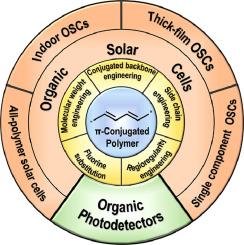Progress in Polymer Science ( IF 27.1 ) Pub Date : 2023-06-25 , DOI: 10.1016/j.progpolymsci.2023.101711 Chunchen Liu , Lin Shao , Shihao Chen , Zhengwei Hu , Houji Cai , Fei Huang

|
π-Conjugated polymers show promising potential in the application of organic photovoltaics, including organic solar cells (OSCs) and organic photodetectors (OPDs) because of merits of light-weight, flexibility, facilely tuned color, large-scaled solution-processability, etc. Over the past three decades, various π-conjugated polymers have been developed owing to the continuous efforts of researchers, which significantly promote the OPVs technology to an unprecedented stage. In order to reveal the relationship among polymer structures to the optical and electronic properties and interchain aggregation and morphology and finally to device performance, it is of great significance to review the progress of π-conjugated polymers for OPVs, particularly for outstanding achievements in recent all-polymer solar cells (all-PSCs), indoor organic photovoltaics (IOPVs), thick-film OSCs, single-component organic solar cells (SCOSCs) and short-wave infrared (SWIR) OPDs. This review highlights general design strategies of π-conjugated polymers for high-performance OPVs, including conjugated backbone engineering, side-chains engineering, regioregularity engineering, halogen substitution and molecular weight control. Then, the development of conjugated polymers for all-PSCs, IOPVs, thick-film OSCs, SCOSCs and OPDs has been summarized. At the end, we summarize the challenges and future directions for studying π-conjugated polymers for OPVs. Therefore, an in-depth understanding of designing π-conjugated polymers is speculated to advance the development of current OPV materials and thus accelerate the ultimate industrialization of the OPV technology.
中文翻译:

用于有机光伏的π共轭聚合物的最新进展:太阳能电池和光电探测器
π共轭聚合物具有重量轻、柔韧性好、易于调节颜色、可大规模溶液加工等优点,在有机太阳能电池(OSC)和有机光电探测器(OPD)等有机光伏应用中显示出广阔的前景。。近三十年来,经过研究人员的不断努力,各种π共轭聚合物被开发出来,极大地将OPV技术推向了一个前所未有的阶段。为了揭示聚合物结构与光学、电子性能、链间聚集和形貌以及最终与器件性能的关系,回顾OPV用π共轭聚合物的进展,特别是近年来的杰出成就具有重要意义。 -聚合物太阳能电池(全PSC)、室内有机光伏(IOPV)、厚膜OSC、单组件有机太阳能电池(SCOSC)和短波红外(SWIR)OPD。本综述重点介绍了高性能 OPV 的 π 共轭聚合物的一般设计策略,包括共轭主链工程、分子量控制。然后,总结了用于全PSC、IOPV、厚膜OSC、SCOSC和OPD的共轭聚合物的发展。最后,我们总结了用于 OPV 的 π 共轭聚合物研究的挑战和未来方向。因此,深入了解π共轭聚合物的设计有望促进现有OPV材料的发展,从而加速OPV技术的最终产业化。



























 京公网安备 11010802027423号
京公网安备 11010802027423号